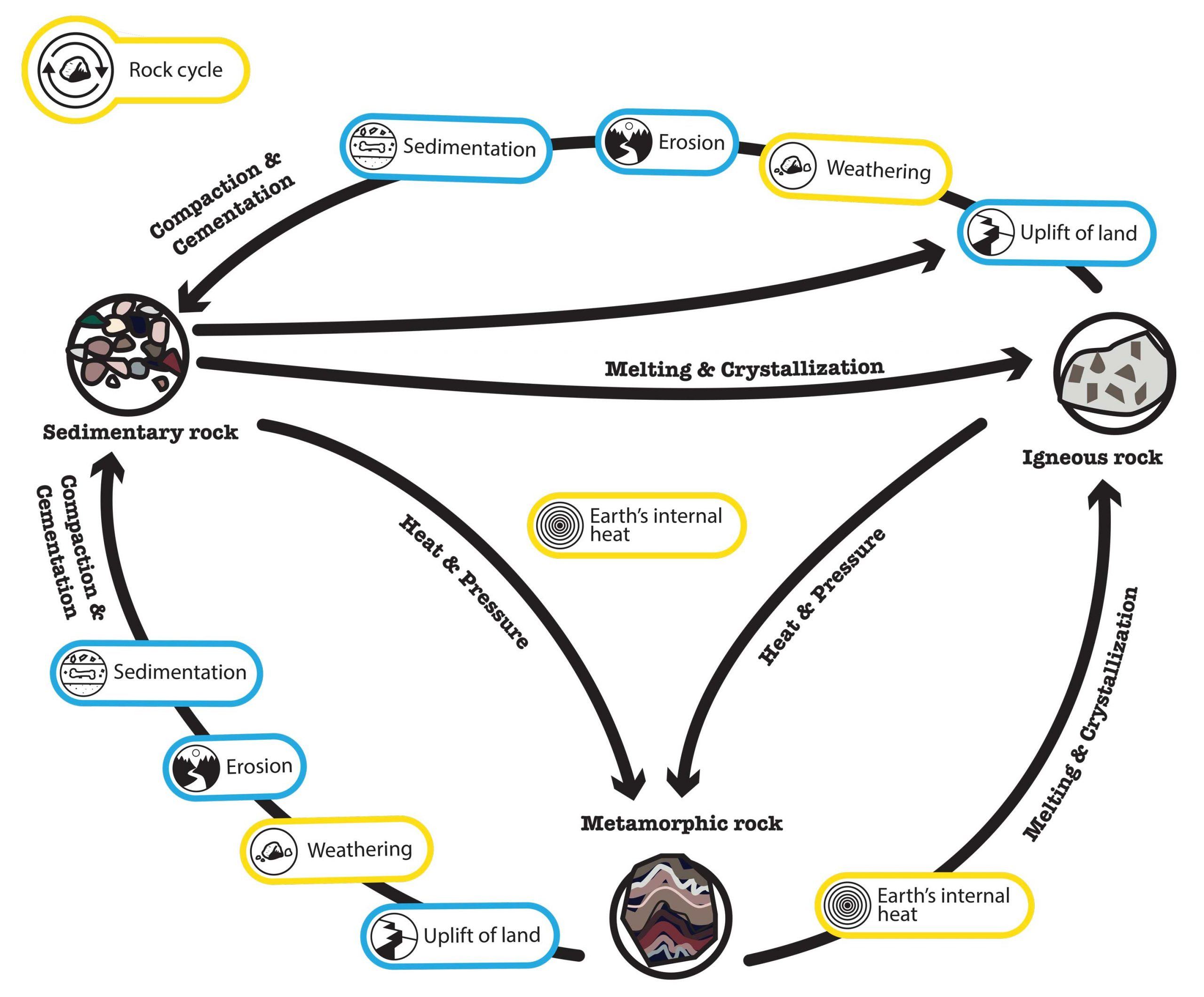Rocks are fundamental components of our planet, each telling a story of Earth’s dynamic processes. From the towering mountains to the ocean floor, rocks are constantly being formed, transformed, and reformed in a continuous process known as the rock cycle. Understanding the Rock Cycle Diagram is key to grasping these geological transformations.
The rock cycle isn’t a simple linear path, but rather a complex series of processes where rocks change between three main types: igneous, sedimentary, and metamorphic. This transformation is driven by Earth’s internal and external forces, including heat, pressure, weathering, and erosion. A rock cycle diagram visually represents these pathways, making it easier to understand the relationships between different rock types and the processes that drive their changes.
 Rock Cycle Diagram: A visual representation illustrating the continuous processes of rock transformation between igneous, sedimentary, and metamorphic types, driven by geological forces like heat, pressure, weathering, and erosion.
Rock Cycle Diagram: A visual representation illustrating the continuous processes of rock transformation between igneous, sedimentary, and metamorphic types, driven by geological forces like heat, pressure, weathering, and erosion.
Unpacking the Rock Cycle Diagram
A typical rock cycle diagram illustrates the three main rock types as interconnected segments of a circle or a similar cyclical flow chart. Arrows indicate the processes that lead from one rock type to another. Let’s break down the key components often depicted in a rock cycle diagram:
-
Igneous Rocks: These rocks are born from molten rock, known as magma beneath the Earth’s surface and lava when it erupts onto the surface. The diagram shows that cooling and solidification of magma or lava forms igneous rocks. Examples include granite, which cools slowly underground, and basalt, which cools rapidly from volcanic eruptions.
-
Sedimentary Rocks: Weathering and erosion break down all types of existing rocks into smaller pieces called sediments. These sediments are then transported by wind, water, or ice, and eventually deposited in layers. Over time, compaction and cementation of these sediments lead to the formation of sedimentary rocks. The rock cycle diagram highlights weathering and erosion as the processes leading to sediments, and subsequent processes forming sedimentary rocks like sandstone, shale, and limestone.
-
Metamorphic Rocks: When existing rocks (igneous, sedimentary, or even other metamorphic rocks) are subjected to intense heat and pressure deep within the Earth, they undergo metamorphism. This process changes their mineral composition and texture, creating metamorphic rocks. The diagram shows that heat and pressure are the transformative forces for creating metamorphic rocks such as marble, slate, and gneiss.
The rock cycle diagram also clearly illustrates the transitions between these rock types. For instance, igneous rocks can be weathered and eroded to become sediments, which then form sedimentary rocks. Sedimentary and igneous rocks can be subjected to heat and pressure to become metamorphic rocks. Furthermore, any of these rock types can be melted back into magma, starting the cycle anew with the formation of igneous rocks.
The Driving Forces Behind the Rock Cycle
Several Earth processes power the rock cycle, as shown in the diagram and in reality:
-
Earth’s Internal Heat: The heat from Earth’s interior, stemming from radioactive decay and residual heat from formation, is a primary driver. This heat melts rocks into magma and provides the energy for tectonic plate movement, which in turn causes mountain building and metamorphism.
-
Tectonic Processes: Plate tectonics, the movement of Earth’s lithospheric plates, plays a crucial role. Plate collisions create pressure and heat, leading to metamorphism and mountain uplift, exposing rocks to weathering and erosion. Volcanic activity, also linked to plate tectonics, brings magma to the surface to form igneous rocks.
-
Weathering and Erosion: External forces like wind, water, ice, and even biological activity constantly break down rocks at the Earth’s surface. This weathering and erosion produce sediments, the raw material for sedimentary rocks. Climate conditions significantly influence the rate of weathering.
-
Sedimentation: The deposition of sediments in basins like oceans, lakes, and rivers is crucial for forming sedimentary rocks. The type of sediment and the environment of deposition influence the characteristics of the resulting sedimentary rock.
Human activities also increasingly impact the rock cycle. Extraction of rocks and fossil fuels, urbanization, deforestation, and agricultural practices can accelerate erosion, alter sedimentation patterns, and even contribute to weathering through pollution.
Understanding the rock cycle diagram provides a framework for comprehending the interconnectedness of Earth’s geological processes and the continuous transformation of our planet’s rocks. It showcases a dynamic system where each rock type is not static but is part of an ongoing journey of change over geological time.